Cell phones have come a long way since their debut in the early 1980s. They've gone from an expensive and rare luxury item to a ubiquitous technology that most people can't imagine living without. But when did cell phones become popular? And what factors led to their widespread adoption?
The first mobile phone went on sale in the US in 1983. Cell phones started becoming popular in the early 2000s. By 2007, around 3.3 billion mobile devices were in use. Some countries now have more cellular phones than people.
One of the critical factors that led to their widespread adoption was the development of the smartphone, which made cell phones more powerful and capable than ever before. Let's look at the cell phone's history and how it has transformed our lives.

3 Reasons Cell Phones Became Popular In The 2000s
Here are three factors that created the perfect storm that led to the widespread adaptation of cell phones in the 2000s. Source: The book How do cellphones work?
1. More Useable for Personal Communication
In the early days of cell phones, they were primarily used by businesses and governments because of their higher price tags.
But as technology advanced and prices dropped, cell phones became more commonplace. More people used them for personal communication over landlines leading to increased demand. This demand drove down prices even further. And the cycle continued, with cell phones becoming even more ubiquitous and affordable over time.
2. Advances in Cellular Network
Cellular network technology saw significant advancements in the 2000s, making cell phones more accessible and popular.
In mid-2001, the first commercial 3G network was launched in Japan, and by 2010, there were over 2.3 billion 3G subscribers worldwide.
These advancements allowed faster downloads, web browsing, streaming, and better voice quality and video calling.
3. The Release of the Apple iPhone in 2007
The release of the Apple iPhone in 2007 was a watershed moment for cell phone technology.
The iPhone had an innovative and sleek design, but it also operated on a new operating system, which turned the mobile phone into a mini-computer that could surf the internet and run applications like desktop computers.
The iPhone was marketed as a "smartphone" that could do more than make calls and send texts.
Today, smartphones are more popular than ever and show no signs of slowing down.
Fiction Anticipated The Development Of Cell Phones: The Imagination Always Paves The Way To New Inventions
Science fiction has always been a harbinger of future technology, and it's not surprising that some of the earliest depictions of cell phones can be found in science fiction.
The earliest example is Lewis Baumer, who published a cartoon in Punch entitled "Forecasts for 1907." He showed a man and a woman in London's Hyde Park using wireless telegraphy to date and gamble.
Later in 1923, Ilya Ehrenurg mentioned "pocket telephones" as one of the latest technological advancements in his collection of short stories, Thirteen Pipes.
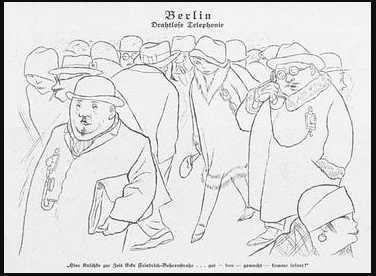
Source: Wikipedia
Another artist, Karl Arnold, drew a visionary cartoon about the use of mobile phones in the street in 1926. The German satirical magazine Simplicissimus published the picture "wireless telephony."
Part A: A History of Mobile Phones (1973- 1989) Time Lapse
1. The Forgotten Story of Car Phones: The First Mobile Phones
Source: Wikipedia
Back in the day, car phones were a must-have for anyone who wanted to stay connected while on the go.
Nowadays, everyone has a cell phone, and there's no need for a separate car phone. But back in the day, car phones were a big deal.
They worked by connecting to the car's electrical system and using its speaker and microphone to make calls.
They were bulky and heavy, but they allowed people to stay connected even on the road.
And, of course, they were popular among celebrities and wealthy businesspeople who could afford them.
2. The First handheld Cell Phone Prototype: Martin Cooper At Motorola (1973)
Martin Cooper is best known for his invention of the first handheld cellular phone, which he developed while working at Motorola.
In April 1973, Cooper made the world's first cellular phone call from a street in New York City to his rival at Bell Labs, Joel Engel. Source: The book Cell Phones and Smartphones
This early prototype was massive and weighed 2 pounds. The battery took 10 hours to recharge, but it paved the way for the development of today's smartphones.
3. Motorola Took 10 Years To Build The First Commercial Cell Phone: Motorola DynaTAC 8000x (1983)
The Motorola DynaTAC 8000x was the first commercially available cell phone. It was released in 1984 and took ten years to develop.
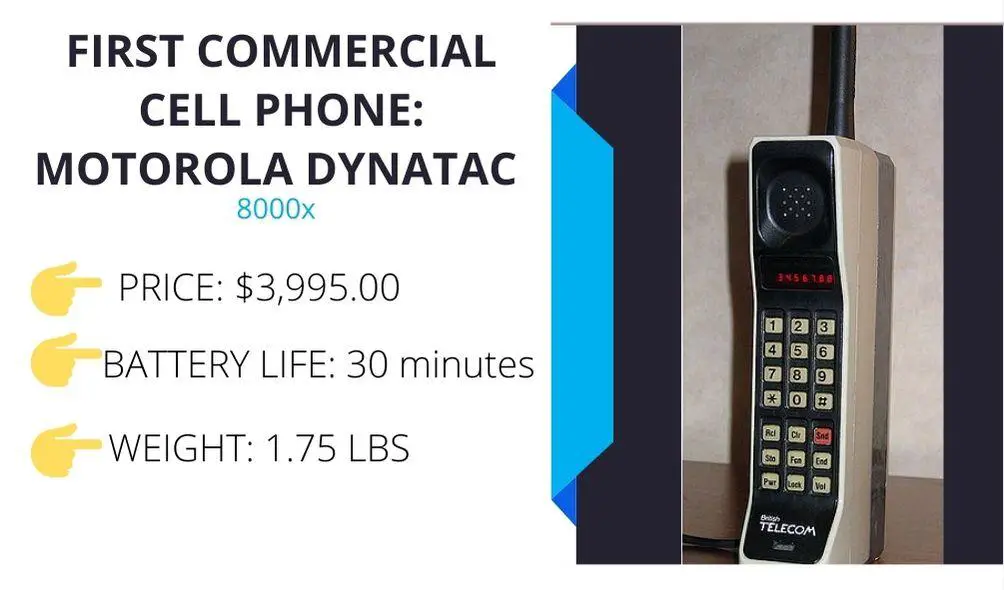
The DynaTAC(Dynamic Adaptive Total Area Coverage)8000x had several features, including:
A full keypad with numeric buttons
A full charge took 10 hours
30 minutes talk time
Price was $3,995, equivalent to $9,952 in 2020
4. The First Flip Phone: The MICROTAC 9800X (1989)
The MicroTAC 9800X by Motorola was the first flip phone. It was released on April 25, 1989.
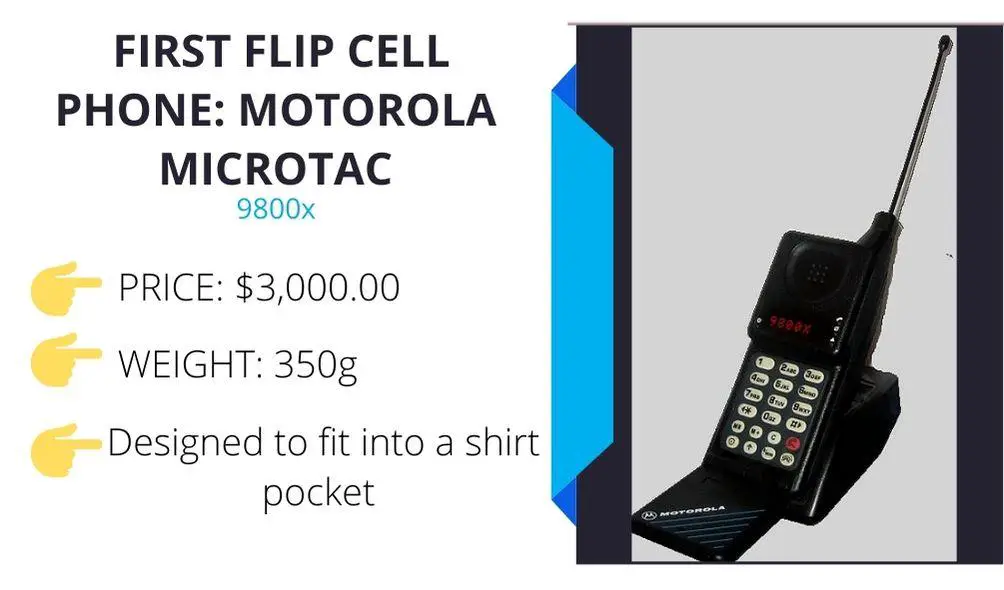
The phone was released as the "MicroTAC Pocket Cellular Telephone," and was designed to fit into a shirt pocket.
The MicroTAC(Total Area Coverage)9800x had several features, including:
The phone introduced a new flip design where the mouthpiece covered the keypad.
It used an 8-character dot-matrix display that helped show more information than the previous Motorola DynaTAC 8000X.
Back To The Past: What Was The User Experience Of Using Cellular Phones From The 1980s (1G phones)?
1G networks were the first generation of cellular networks. They are the original analog, voice-only cellular telephone standard.
They were introduced in the early 1980s and provided essential voice-calling functionality.
The first commercial 1G mobile network was launched in Japan by NTT Docomo in 1991, and Ameritech Corporation followed and launched its own in the United States in 1983.
User Experience Of 1G Mobile Phones:
Receiving calls - people could hear background noise, such as cars driving by, and it wasn't easy to have a conversation.
Limited talk time and no long-distance service.
No voicemail or call waiting.
Inability to access the internet or send text messages.
A very short battery life.
Part B: The History Of Mobile Phones (The 1990s Time Lapse)
1. A Piece of History: How Nokia Changed The Mobile Phone Industry Forever In 1993
Phone networks were initially designed to carry voice calls, but text messaging quickly became an area of interest after the development of 2G cellular networks.
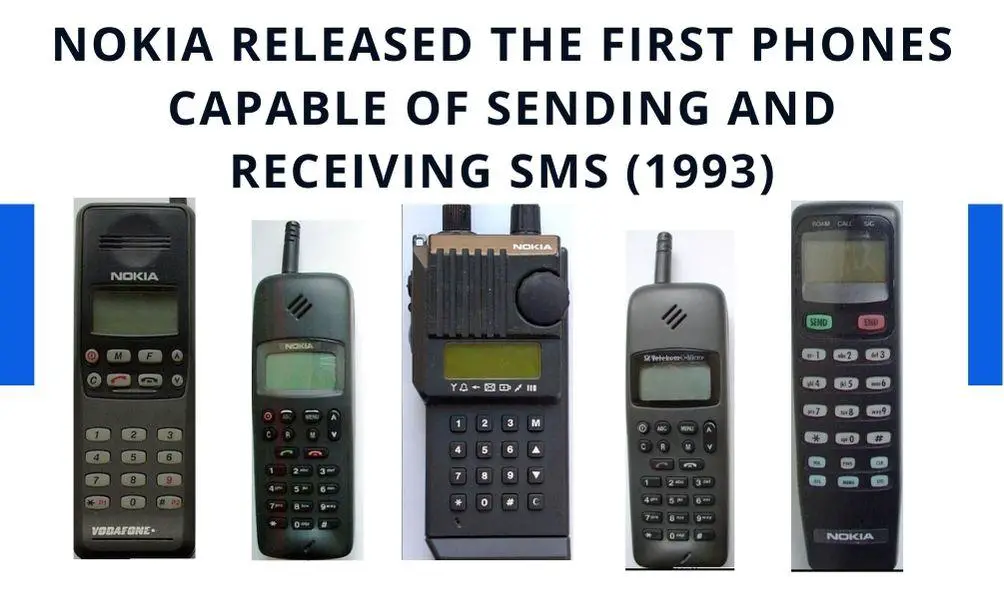
The first SMS message was sent from a computer on December 3, 1992, by a British engineer named Neil Papworth.
He sent the message "Merry Christmas" to Vodaphone Executive Richard Jarvis, who celebrated the holiday at a party.
And then, in 1993, Nokia released the first phones that could send and receive text messages. But until 1999, people could only send text messages to each other if they were using the same service provider.
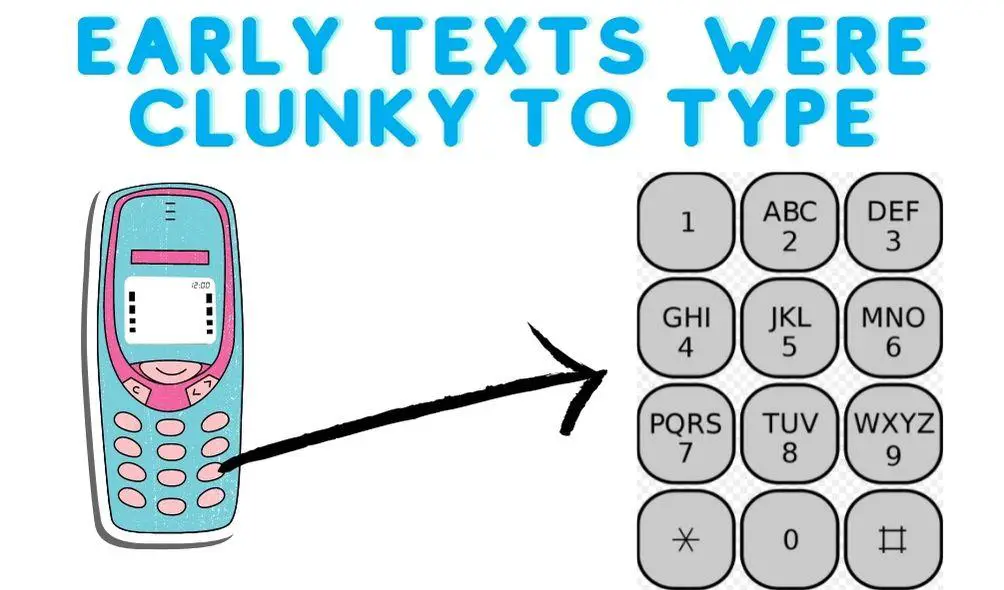
Early text messages were difficult to type. Cell phone number keys represented four letters of the alphabet.
For example, the number 6 key represented the letters M, N, and O. Typing M took one tap. But typing N took two taps, and typing O took three. This made it difficult to text multiple words or sentences.
2. World's First Smartphone: IBM Advanced Cell Phone Simon (1994)
A look back in time. Before the iPhone and Android, the world's first smartphone by IBM was Advanced Cell Phone Simon.
The IBM Simon is considered the ancestor of modern smartphones. It was made commercially available to the general public on August 16, 1994.
Simon also created the first mobile phone game, Scramble. It featured a calendar, calculator, fax, email, and PDA capabilities. People could use a stylus to tap keys, draw, etc.

However, this phone did not sell well due to its huge size. Other smaller and more portable phones were more popular.
3. Siemens S10: The WORLD'S First Phone With A Color Screen (1997)
The Siemens S10, introduced in 1997, was the first phone with a color screen. It had a resolution of 97x 54 pixels and could display up to 6 lines.
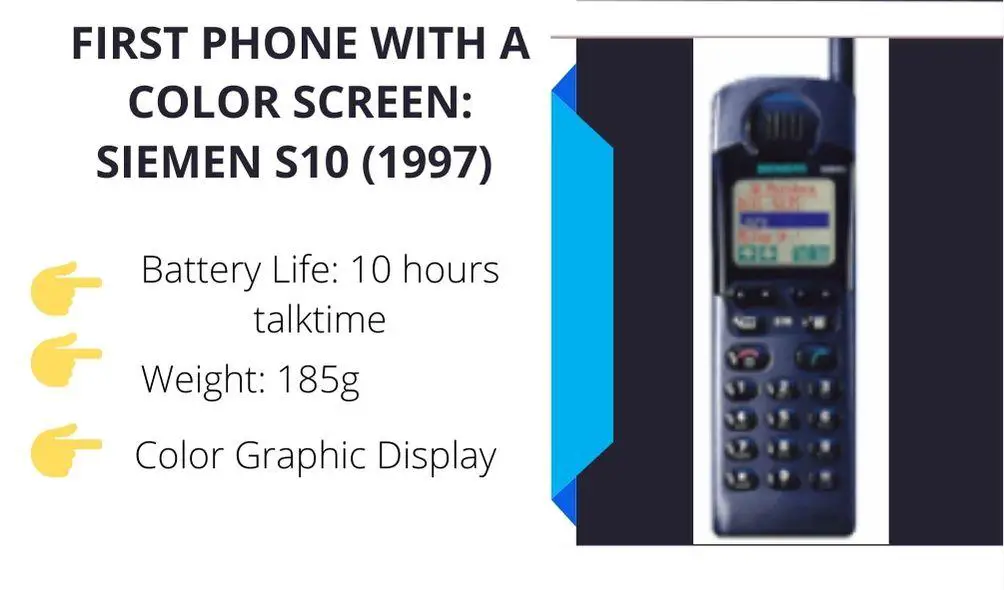
The S10 was a product that failed to make an impression when it came out, but it later became an industry standard.
The color screen on the phone was not very good. It showed text in four colors but had a text-only display with a few symbols. Reviewers at What Cellphone did not like it. They thought the color screen made the phone difficult to use.
4. Nokia 9000 Communicator: The First Cell Phone To Access The Internet (1997)
The Nokia 9000 Communicator was released on August 15, 1997.

The Nokia 9000 communicator was different from other phones at the time because it could be flipped on its side and had a large display screen.
Plus, it could access the internet! This allowed people to do more with their phones and made the term "smartphone" famous.
The phone was heavy, but it was considered powerful. It even closed in on multiple awards, such as GSM World Award (for innovation) at GSM World Conference 1997 and Best New Product 1997 by Business Week magazine.
5. Nokia 7110: The First Phone To Have A WAP WEB Browser (1999)
The Nokia 7110 was released in October 1999, and it was the perfect phone for busy professionals.

It was the first personal cell phone to use the T9 Predictive text input; the user could easily compose text messages.
And with its WAP web browser, you could keep up with online tasks even when you're away from your computer.
The phone was intentionally designed with a sliding cover that could be used to answer and terminate calls. It also brings the microphone closer to your mouth for improved voice reception.
What Was The User Experience Of Using Cellular Phones From The 1990s?
Second-generation (2G) networks are digital cellular networks introduced in the early 1990s.
They are the first generation of cellular technologies to allow full texting, web browsing, downloads, and emailing on mobile devices.
User Experience Of 2G Mobile Phones:
I remember using 2G phones. They were slow, and the call quality wasn't great, either. I'm glad that we've moved on; here come the features :
Slow when loading websites
The battery life was still not very long
The reception was not always good, so some areas had trouble connecting.
Part C: The History Of Mobile Phones (The Early 2000s Time Lapse )
1. J-SH04: The World's First Cellular Camera Phone (2000)
The J-SH04 Camera Phone was the world's first to feature a built-in back-facing camera.
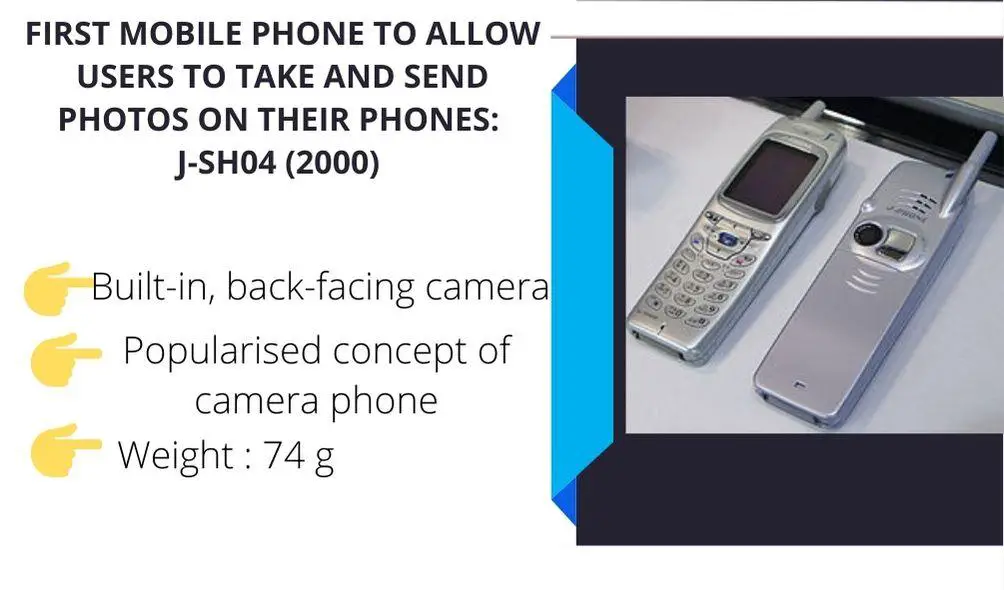
Sharp Corporation released this innovative phone in November 2000. It featured a 0.11 megapixel CMOS image sensor and a 256 color display and could take photos facing away from the user.
At the time, taking photos facing away from you was more popular than taking video calls or selfies.
The phone also had access to the internet, so cell phone users could take pictures with the phone and email them to friends and family.
2. BlackBerry Quark: It Took The Mobile World By Storm (2003)
The BlackBerry Quark was one of the first models to be popular worldwide.
Blackberry was loved for its great features.
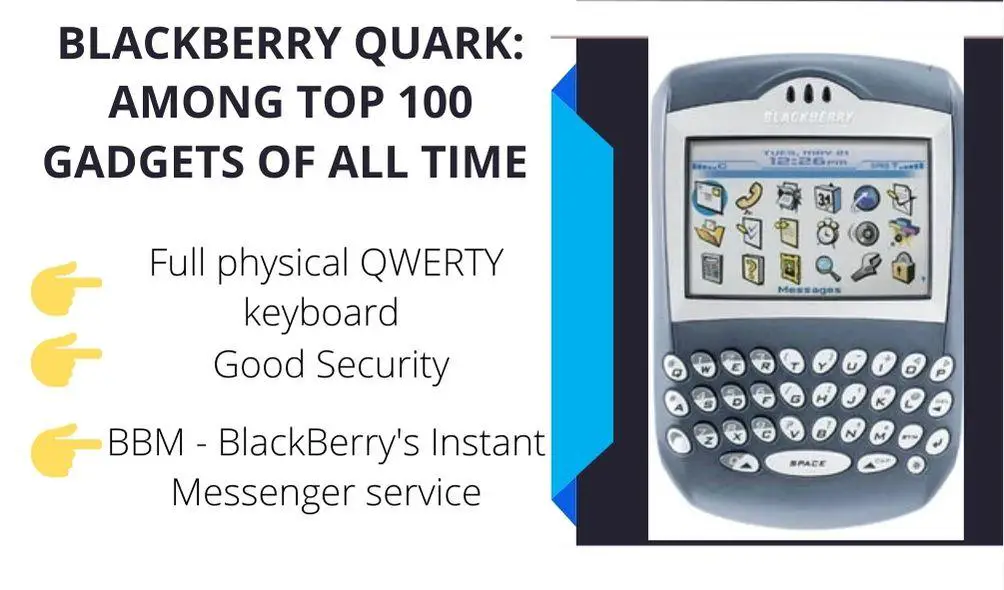
The full QWERTY physical keyboard made it easy to type out emails and messages, and with BBM, you could stay in touch with friends and colleagues in real-time.
The BlackBerry platform was known to provide unbeatable security features that made it a favorite among business users and government officials.
However, BlackBerry later lost its dominant position in the market because of the success of Android and iOS platforms.
3. iPhone 2G: The First iPhone That Brought About A Mobile Evolution (2007)
Apple Computer, Inc. released the iPod in 2001. This popular device changed the way people bought and listened to music. Next, Apple co-founder and CEO Steve Jobs set his sights on the mobile phone market.
The iPhone 2G is Apple's first smartphone, released in June 2007.
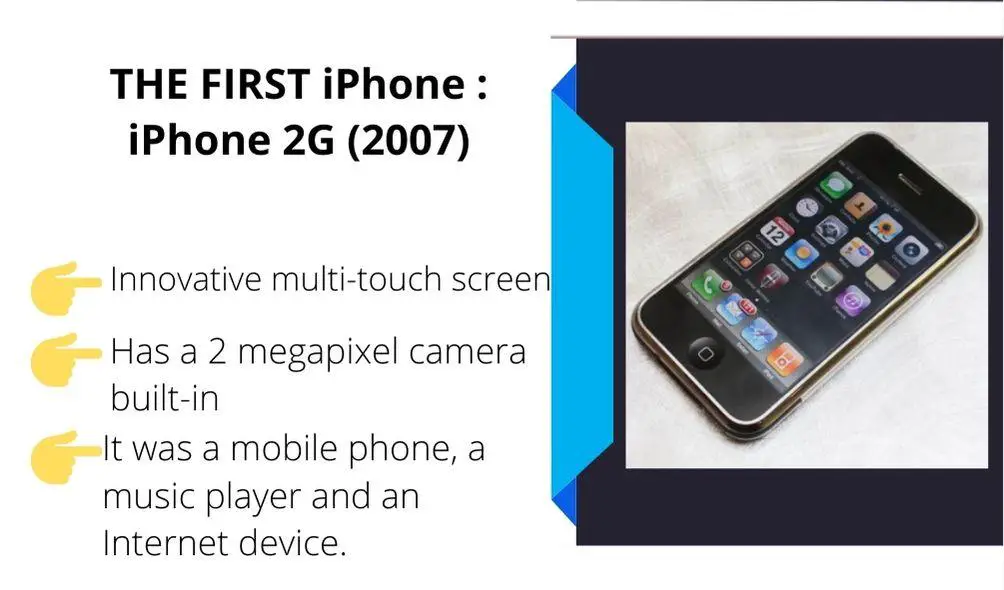
The smartphone was revolutionary in that it had features no other phone at the time possessed.
Also, Apple's strong marketing and branding made it the company's most successful product. Apple became the most successful company at that time.
One might ask, how was the iPhone different from other phones?
The iPhone had a revolutionary user interface. It had no physical keyboard buttons. It also didn't have a stylus like most other phones. Instead, it replaced the physical buttons with a multi-touch screen.
Apps were the driving force behind developing a multi-touch display over a full physical keyboard.
Since each app required a different keyboard, Apple felt that apps would allow for creating a mobile device-based economy, so they removed the physical keyboard on the iPhone.
The iPhone was one of the first handheld devices to have a great operating system. This meant it could play multimedia, make phone calls, and browse the internet on the same device.
Here is a detailed review of the original iPhone.
4. T-Mobile G1: The First Android Phone (2008)
Android first existed as a company to develop an improved operating system for digital cameras.
When Google learned of Android's plans in 2005, the company bought Android. Working for Google, Android began to develop a new mobile OS.

Google then teamed up with cell phone company T-Mobile to create a device that ran the Android OS. The first Android phone, the T-Mobile G1, was released in 2008.
The T-Mobile G1 had many features similar to the iPhone. Here is an excellent review of this phone.
5. Samsung i7500: The First Samsung Galaxy Powered with Android OS Arrived and Became iPhone's Biggest Competitor (2009)
The Samsung GT-i7500 Galaxy is also known as the original Galaxy.
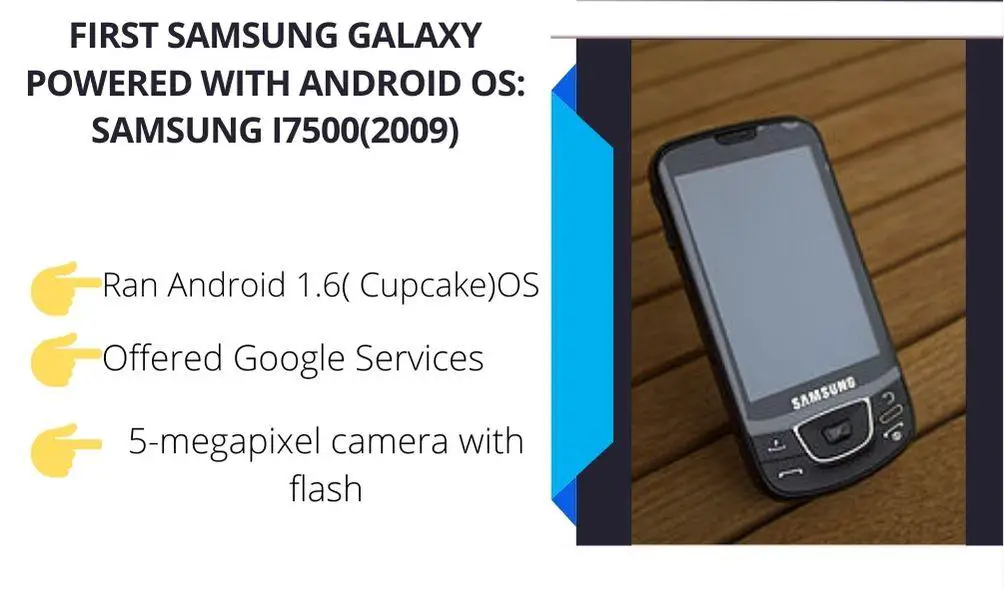
It was released in June 2009 and marked the beginning of the journey between Samsung Mobile and the Android OS.
The Samsung Galaxy has come a long way. It is the only brand that has managed to become the iPhone's biggest competitor in terms of overall smartphone sales.
Smartphones have come a long way in a short amount of time. The trend is only expected to continue, with even more advanced features and capabilities making their way into our pockets.
So, should you buy an expensive smartphone? That depends on your needs and budget.